History
Japanese persimmons, Diospyros kaki L., originated in China and were first grown in Florida in the 1870s. At one time, there were commercial plantings of astringent types, numbering about 22,750 trees. Because of marketing difficulties, this industry ceased. California is the largest producer of Japanese persimmons, followed by Florida and southern Texas. According to the 2017 Census of Agriculture data for all persimmons in the United States, most plantings are on a small scale. Of the nearly 2,400 farms growing the fruit, about 70% have less than 1 acre, and 90% have less than 5 acres. Current acreage in Florida is estimated to be 266 acres as of 2017, down from 324 in 2012 and from the estimated high of 500 acres in the mid-1990s. However, the number of farms in Florida growing the fruit has increased from 164 to 227 during the 2012 to 2017 period, further emphasizing the small-scale nature of average acreage of persimmons per farm. Trees grow and fruit best in central and northern Florida and can produce high yields of good-quality fruit. In south Florida, fruit quality is better with astringent types than with nonastringent types.
Japanese persimmons were introduced into the United States by Commander M. C. Perry in 1856. The US Department of Agriculture imported many trees in the 1870s and planted them in the southern United States. Immigrants from China and Japan also brought various cultivars into California prior to 1919. Professor Harold Hume of the University of Florida was one of the first to study the Japanese persimmon in America, and in 1914 he developed a classification system that is the basis for those used today. Hume, along with George Tabor of Glen St. Mary's Nursery, also worked with breeding and cultivar evaluations. During the 1960s and 70s, Judge Ware and Dr. Robert Dunstan imported and evaluated many important Japanese cultivars. With the University of Florida, Professor Ralph Sharpe tested, evaluated, and published information on persimmons. During the 1980s, newer cultivars, especially nonastringent types, were introduced from Japan and studied in the UF/IFAS Horticultural Sciences Department. Florida has a rich history with Japanese persimmons and has been a prominent state for cultivar evaluations, with sites in Gainesville, Chiefland, and Monticello evaluated during the 1980s and 1990s. Botryosphaeria spp. and fungi of the genus Cercospora are major limitations of persimmon production in Florida.
Many persimmon cultivars exist in Florida from both importations and seedling-grown trees. Persimmon names often represent an approximation of the various Asian-language names by which the original imported trees were designated. Today, we have a number of cultivars with Asian-language or pseudo-Asian-language names and meanings, as well as some with American English-derived names. Some of the Asian-language-derived words used have the following meanings: "Kaki" or "Gaki"—persimmon; "Wase"—early; "Hana"—flower of; "Tanenashi"—without seed; "Fuyu"—winter; "Saijo"—best; "Gosho"—imperial palace; "Ichi"—number one; and "Ki"—life.
Persimmon Fruit Characteristics
Classification
Persimmons are classified into two types, astringent and nonastringent, based on fruit characteristics. Astringent cultivars have a taste that puckers the mouth, numbs the tongue, and constricts the throat. This taste is caused by astringent substances such as tannins. The astringent taste is dominant in unripened bananas, unripe persimmons, and acorns, and it prevents them from being eaten (Figure 1). The compound which causes the astringent experience when eating persimmons has been found to be water-soluble tannin (kaki-tannin), which is located in tannin cells of the fruit. When these cells burst in the chewing process, the tannin adsorbs to the protein on the tongue and gives a sensation of dehydration. Astringent fruit must be soft or artificially treated to remove astringency and make them suitable for eating. Fruit of the nonastringent types lose astringency while still hard and can be eaten hard or soft.
The second classification relates to fruit flesh color when seeds are present. In pollination-variant types, the flesh is dark and streaked around the seeds, but clear orange when seedless. Pollination-constant types lack the dark streaking regardless of seed set.
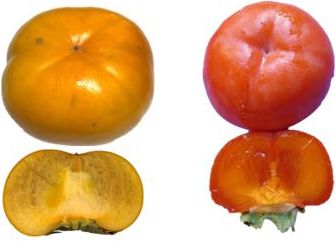
Credit: Ali Sarkhosh, UF/IFAS
In astringent cultivars of the pollination-variant type, the dark flesh is nonastringent even when hard; therefore, seeded, pollination-variant astringent cultivars perform as nonastringent types. The amount of dark flesh coloration around the seeds varies with cultivars. In most areas of the world, astringent pollination-variant types, which have a great amount of dark flesh, are classified as nonastringent cultivars. However, typically in Florida, these persimmons are grown without pollinators, and their seedless astringent fruit necessitates classifying them as astringent types. Some dark specks can be found in the flesh of 'Fuyu' and other nonastringent cultivars. This is not linked to seed set and has no significance to the variant-constant classification system.
Ripening
Harvest season for astringent persimmon fruit is just prior to and through the soft stage of fruit development. If picked during this time, the fruit is either soft or will become soft, and the astringent tannins are coagulated, making the fruit suitable for eating. Generally, fruit can be picked and softened at room temperature about 7 to 10 days before it would soften on the tree. The time varies slightly with cultivars and is about the same for both astringent and nonastringent types. Not all fruit in the crop load develop to this state at the same time. The softening process will be less effective and take longer to occur the earlier the fruit is picked.
Choosing the proper harvest season for nonastringent persimmons is less complicated than for the astringent types because they can be eaten firm. The astringent tannins are broken down earlier in the fruit-development period at a time when the fruit is still hard. They are easier to harvest, store, and market than astringent types and are very popular in many parts of the world. Fruit are harvested by color and can be rated for ripeness by a color chart. The elimination of green by the increasing development of yellow and/or orange to orange-red is a general indication of marketable fruit.
Softening and astringency removal can be induced by covering the fruit with uncooked dry rice for 3–5 days. Freezing the fruit for 24 hours will have similar results. Ethylene gas can be used to speed up the ripening process and develop more fruit color.
Environmental injury, such as picking by birds or scoring by wind, and fruit imperfections, such as tip-end cracks, calyx separations, or apical growth rings, will also induce softening. Generally, the further the fruit is from the soft state when the openings or splits occur, the more localized the ripening spot is on the fruit. With growth-ring cracks and tip splits, the fruit ripen and develop color from the apical end upwards, with the opposite true for calyx separations.
Marketing and Use
The marketing window for fresh persimmons is from September through December. Direct marketing through farmer's markets, on-farm stands, and U-pick operations are common methods to sell the fruit (Figure 2). Astringent-type persimmons can be difficult to market. Many commercially marketed California astringent persimmons, although attractive, have been picked too early. This does not allow the fruit to lose astringency without treatment and gives consumers an unpleasant experience, such that they are reluctant to eat persimmons again. In Japan, to remove astringency, fruit are sprayed with 35%–40% ethyl alcohol and placed in a sealed container for 10 days at 69°F. The firm product is of good quality, is easily marketed, and will soon soften.

Credit: Ali Sarkhosh, UF/IFAS
Greater customer education on the ripening aspect of astringent persimmons and cultivar traits could help marketability, as could offering in-store samples to encourage potential customers. Growing more nonastringent varieties would also be beneficial. A consumer sensory evaluation conducted in 1997 using the nonastringent variety 'Fuyu' found that 51% of participants had never had persimmon before, and that most who tried were surprised and enjoyed the experience, including those who commonly ate astringent varieties. With an estimated population of more than 21 million, a diverse culture base, and large cities close to production zones, Florida is primed for a larger persimmon industry.
In the United States, the ideal use of astringent persimmons is home consumption, drying, and U-pick operations. In East Asian homes, fruit from the garden persimmon tree are peeled, strung or skewered, then hung to dry. Dried fruit are sweet and delicious, with the sugar often crystallized on the fruit surface, making the product white and attractive. The dried peel is used as a dyeing agent. In Florida, sun-drying of halved or sliced fruit in a glass or polyethylene chamber or drying in a commercial food dryer produces a delicious product, ready in 3 to 7 days. The fruit may be sulfur fumigated for better appearance and storage. Drying naturally removes all astringency.
Nonastringent fruit are good for fresh eating and are excellent with pears, dates, apples, citrus, raisins, and/or coconut in salads. They have distinct advantages in marketing and handling because they can be picked earlier and have a longer shelf life. Consumer acceptance is greater because they do not have to be eaten in a "gooey-drippy" state, which is objectionable to many people. To extend their reach into other markets, fruit can also be processed into many baked goods and snack foods. Because persimmons have relatively few pest problems, organic production of the fruit could open another market avenue.
Storage
Generally, because astringent persimmons must be soft or near that state at harvest, they do not store well; however, nonastringent types can store up to 30 days at room temperature. Colors will increase somewhat, sugar will remain the same, and weight will decline 7% to 10%. Only fruit without imperfections store well over a long period. Generally, the early-maturing cultivars such as 'Izu' have a shorter shelf life than late-season ones like 'Fuyu'. In Japan, fruit are individually wrapped in thin polyethylene and stored at 32°F for 4–5 months. The fruit will still be of good quality when removed from storage.
Sugars
Percent of soluble solids or sugars increases for both types of persimmons as the fruit gets closer to the soft, tree-ripened stage. Sugars, measured as soluble solids, in nonastringent fruit average 15% to 20%. Generally, sugars in astringent fruits are slightly higher, sometimes reaching 24% in the later-maturing cultivars. Fructose and glucose make up 90% of the total sugars, with sucrose a minor component.
Texture
The flesh texture of soft astringent and nonastringent fruit varies considerably. Some fruit like 'Saijo' are juicy with a high jelly consistency in the flesh and a translucent, deep-orange appearance. Other fruit like 'Great Wall' and 'Tanenashi' are pasty, somewhat dry, and opaque. Nonastringent fruit are of best quality when crisp like an apple with juicy, orange flesh and a small jelly area in and around the carpels. Some cultivars are quite stringy with fibers that attach to the calyx and go vertically around the carpel section towards the apical end. They are apparent when fruit are soft-ripe. Peel thickness also varies among cultivars, with 'Hiratanenashi' having a thick peel, 'Tanenashi' a medium peel, and 'Saijo' a relatively thin peel.
Physiological Fruit Imperfections
The most common physiological fruit disorder of astringent types occurs on cultivars with conic or round-conic fruit. The disorder is concentric growth rings that appear as small dark lines around the apical end of the fruit. Uneven ripening occurs when these rings split open in the later stages of fruit development.
Separation of the calyx from the flesh section of the fruit is a disorder that appears more commonly on nonastringent than astringent types. A cavity develops in the fruit as the calyx ceases to grow in July, while the flesh section continues to enlarge until harvest. The cavity forms on one side of the calyx and causes uneven ripening, poor storage, and a site for disease infection. Fruit that have a large calyx relative to the size of the fruit at the time of flowering are less likely to develop the disorder.
Splitting at the apical end of the fruit is found on large-fruited, mainly nonastringent types. The splits enlarge and crack during the last month of ripening. They are formed because fusion of the base of the stigma during flowering and early development is incomplete. This disorder is cultivar specific.
Fruit Season
The harvest season, especially for commercially grown nonastringent types, is generally the earliest time when the crop has enough color to be marketed. The crop can remain on the tree a month longer, becoming softer with greater color and sugar. However, there is a consequence for leaving ripe fruit on the tree. Ripe fruit are very susceptible to insect damage and to feeding by mammals (raccoons and possums) and crows. Early fall defoliation will delay and sometimes cease crop ripening. The type of rootstock and certain physiological and environmental conditions may also affect ripening times.
Persimmon Fruit and Tree Dimensions
Fruit Shape
The three general fruit shapes are conic (cone-shaped), roundish (round and sometimes pointed at the apex like an acorn), and oblate (flattened like a large standard tomato) (Figure 3). Some cultivars have other noticeable characteristics, such as an indented ring around the fruit of 'Midia' and 'Tamopan'. Four sides will sometimes be apparent on fruit of 'Great Wall' or 'Saijo'. Distinctly lobed sections are present on 'Sheng' and 'Peiping'. Some cultivars are tucked or folded in at the calyx, like 'Suruga'.
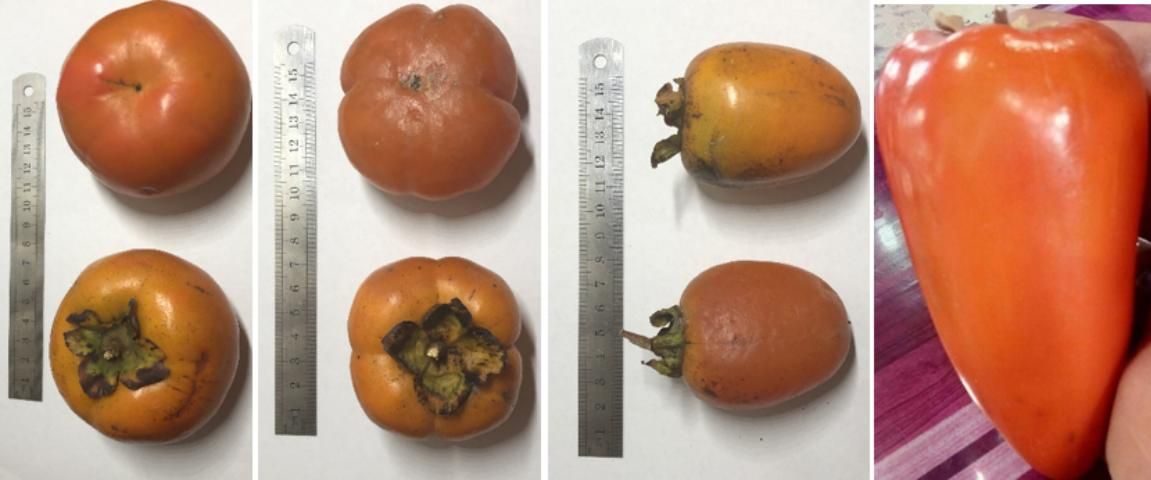
Credit: Ali Sarkhosh, UF/IFAS
Fruit Size
Fruit size is affected by crop loads. The lighter the crop set, the larger the fruit. Small fruit generally weigh 3.5 oz (100 g) to 4.5 oz (130 g), medium fruit range from 5.5 oz (150 g) to 7.0 oz (200 g), and large fruit range from 8 oz (230 g) to 14 oz (400 g) (Figure 4).
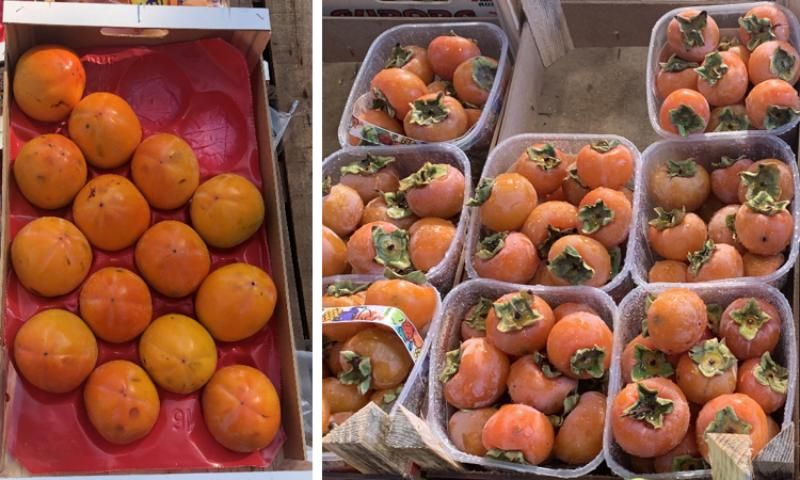
Credit: Ali Sarkhosh, UF/IFAS
Tree Size and Shape
Semi-dwarf plants reach a height of around 6 to 8 ft and have a rounded spreading top (Figure 5). 'Makawa Jiro' and 'Ichikikei-Jiro' are examples of this type. Trees of medium size tend to be taller with more upright shoots. Their limbs are usually spread with crop loads. By far, most persimmon trees fall into this category. Trees in the tall class are upright and often have small fruit. Generally, tree size is reduced south of Gainesville to south Florida. It has been observed that trees grown in Florida are often smaller than would be expected in their native land; common cultivars barely reached 10 ft in height after 10 years in trials during the 1960s.

Credit: Ali Sarkhosh, UF/IFAS
Descriptions of Some Nonastringent Cultivars
Early-Season Cultivars
'Izu' has the distinction of being the earliest ripening nonastringent cultivar (Figure 6). Tree vigor is very low, and it is not precocious. Fruit size is medium-large, and soluble solids average 16%. Fruit shape is oblate, and a fair percentage of fruit show imperfections. Harvest season is late September through mid-November. 'Izu' is sometimes recommended due to early ripening.
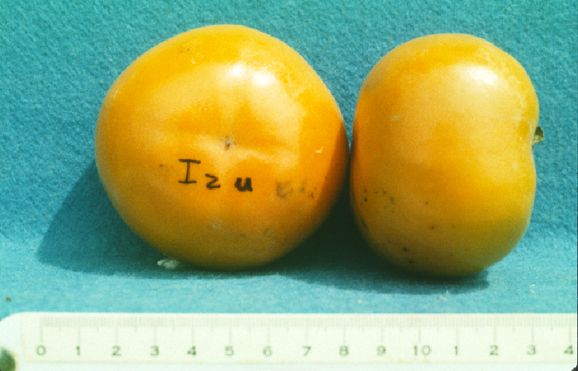
Credit: UF/IFAS Horticultural Sciences Department
Mid-Season Cultivars
'Matsumoto Wase Fuyu' is an earlier-ripening bud sport of 'Fuyu' (Figure 7). The tree sets many flowers and produces heavy, clustered crops. The clusters should be thinned to prevent bent limbs with excessive fruit loads. Larger fruit are sometimes prone to calyx separation. The tree is moderately vigorous and of medium size. Soluble solids range from 16% to 19%, which is generally true for most mid-season types. Fruit is medium in size and oblate in shape. There is little or no tendency for fruit to incur tip cracking.

Credit: Edible Landscaping LLC
'Ichikikei Jiro' is a bud sport of Jiro and is low to moderate in vigor (Figure 8). It blooms later than most persimmon cultivars. Fruit size is medium-large with soluble solids of 16% to 19%. Some fruit sustain tip cracking. Fruit are oblate. Harvest season is mid-October to mid-November. 'Ichikikei Jiro' is recommended for north and north central Florida.

Credit: Edible Landscaping LLC
'Jiro' is moderate in tree vigor. Cropping can be erratic when trees are young, but more consistent yield is produced on older trees (Figure 9). Fruit size is medium-large, soluble solids are 16%–19%, and fruit shape is oblate. Some tip cracking on fruit may occur. Harvest season is mid-October through mid-November. 'Jiro' is recommended.
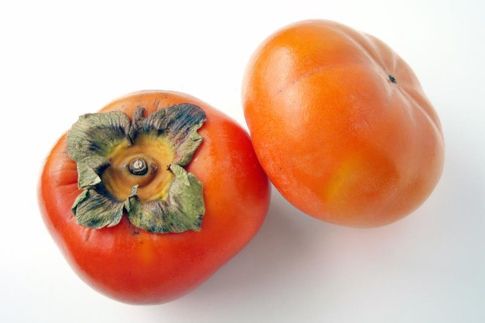
Credit: Edible Landscaping LLC
'Maekawa Jiro', a bud sport of Jiro, is low to moderate in vigor (Figure 10). Fruit size is large, and fruit shape is oblate. There is some tendency for fruit to incur tip cracking. Harvest season is mid-October to mid-November. 'Makawa Jiro' is not recommended for north and north central Florida.
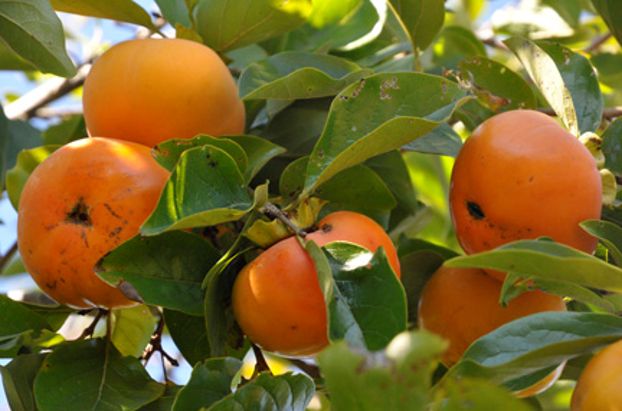
Credit: Edible Landscaping LLC
'Midia' trees are moderate in vigor but are more susceptible to tree decline than most other Japanese persimmons (Figure 11). Fruit set and fruit retention until harvest are not consistently high. 'Midia' produces the largest fruit of any cultivar of nonastringent persimmon. Fruit shape is round with an indented ring around the top of the fruit. Harvest season is late October to mid-November. 'Midia' is not recommended for north and north central Florida.

Credit: UF/IFAS Horticultural Sciences Department
'Hana Fuyu', also known as 'Yotsundani', or 'Giant Fuyu', regulates crop loads well and is of medium vigor (Figure 12). The fruit are slightly larger than most, are generally free of imperfections, and may be slow to lose astringency. The tree is a good homeowner cultivar.
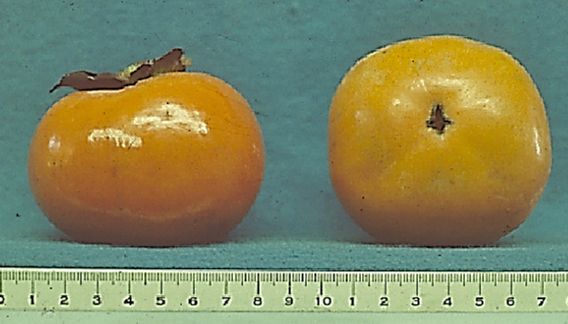
Credit: UF/IFAS Horticultural Sciences Department
'Hanagosho' is a large tree with vigorous upright growth and a strong scaffold system (Figure 13). The tree will usually have a small amount of male flowering every year, and crop regulation is good. The fruit and leaves are slightly more susceptible to late-season pathogens than most cultivars. 'Hanagosho' is a large tree and a good homeowner cultivar.
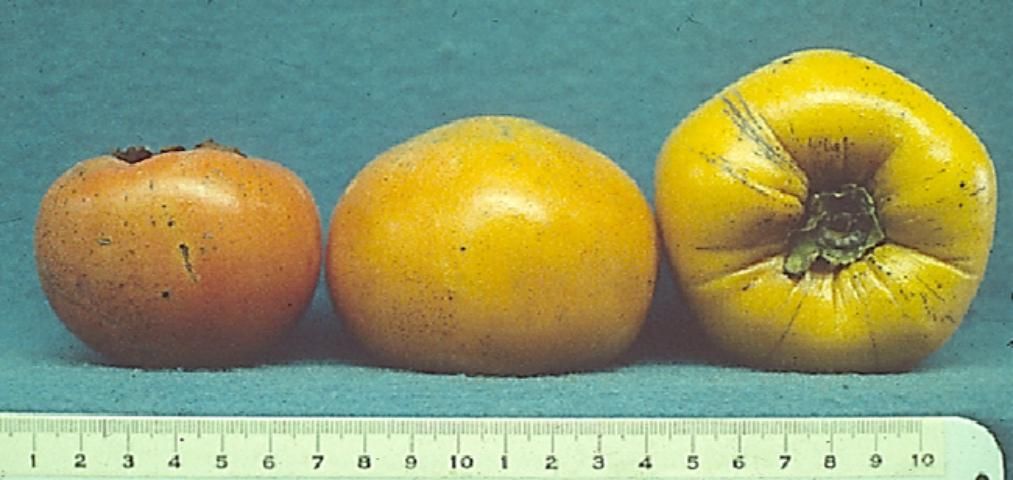
Credit: UF/IFAS Horticultural Sciences Department
'Shogatsu' is similar to 'Hanogosho' in tree habit; however, more problems with fruit end splitting and leaf spots occur (Figure 14).
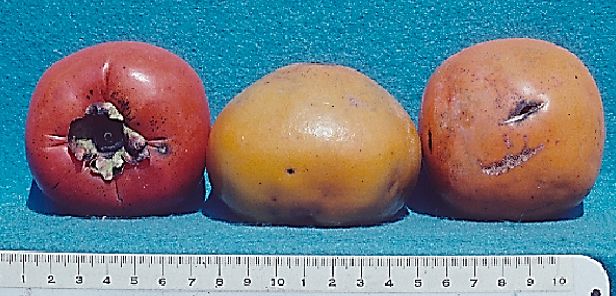
Credit: UF/IFAS Horticultural Sciences Department
Late-Season Cultivars
'Fuyu', also known as 'Fuyugaki', is the most popular nonastringent tree in Florida and is the most widely grown persimmon cultivar in the world. It is weakly 4-sided and firm when ripe, with very few seeds (Figure 15). Fruit thinning is usually necessary to ensure large fruit, prevent clustering, and regulate crop loads. Incidence of fruit imperfections is low, yields are good, and the tree is generally well adapted, with a soluble solids average of 18%. Many different cultivars with the name 'Fuyu' or 'Fuyugaki' exist. Fruit shape is oblate and few fruit show imperfections. Harvest season is mid-November through early December. 'Fuyu' is highly recommended for north and north central Florida.
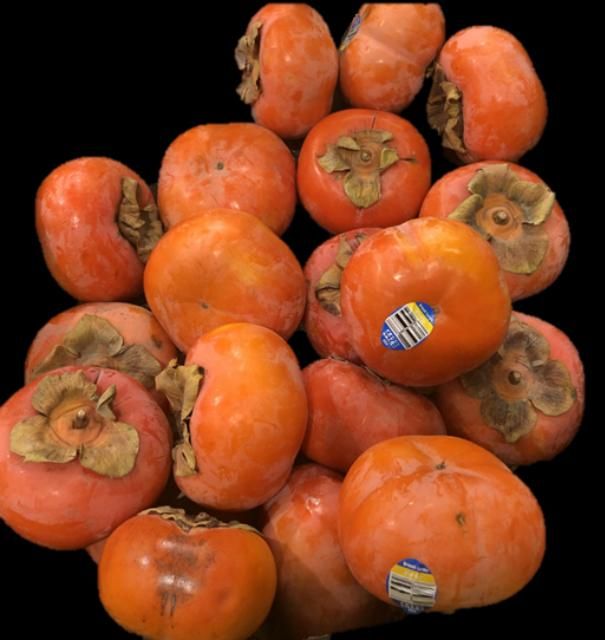
Credit: Ali Sarkhosh, UF/IFAS
'Suruga' trees are moderate in vigor (Figure 16). They produce late-ripening fruit that are exceptionally sweet (soluble solids = 18%–21%). Their fruit shape is classified as oblate conic, and fruit imperfections are fairly common. Fruit size is medium large. Harvest season is late November to early December. It appears to be susceptible to premature defoliation. 'Suruga' is not recommended for commercial cultivation.
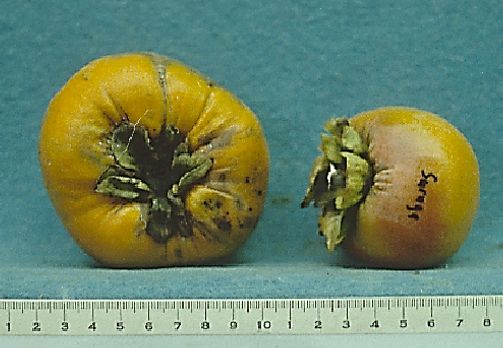
Credit: UF/IFAS Horticultural Sciences Department
Recommended Commercial Cultivars
Plantings of nonastringent persimmons can be made to include cultivars that will ripen fruit from late September to early December. The cultivars recommended seem to produce the highest percent of marketable fruit. 'Izu' is the choice for the early season, 'Matsumoto Wase Fuyu' for the mid-season, and 'Fuyu' for the late season. 'Fuyu' is the most readily available and is generally considered the best commercial nonastringent cultivar in Florida.
Descriptions of Some Astringent Cultivars
Early-Season Cultivars
'Nishumura Wase' is an early cultivar, ripening its first fruit in early August (Figure 17). It is pollination variant and must be fully seeded to be nonastringent. It consistently sets male flowers. The fruit have soluble solids around 13% to 15% and are somewhat watery. The tree is well-spreading, somewhat vigorous, and a good annual cropper.

Credit: Sperling Nursery and Gift Shop
'Saijo' is considered one of the sweetest persimmons, although traces of astringency sometimes remain when the fruit is soft (Figure 18). Fruit ripen early to mid-season and are relatively small with a long conic shape, and a translucent orange jelly-type flesh. Soluble solids range from 16% to 22%. The large, upright, vigorous tree is capable of producing heavy yields. It is a good homeowner type.
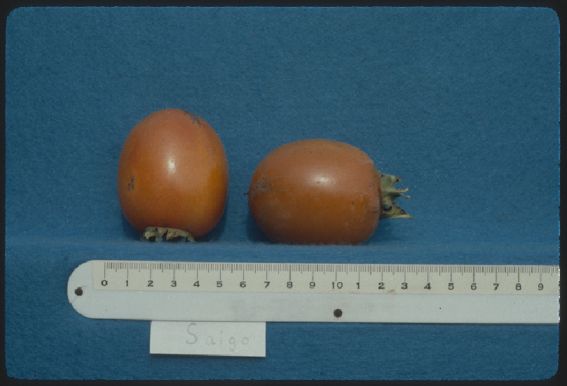
Credit: UF/IFAS Horticultural Sciences Department
'Giombo' is similar to 'Saijo' in fruit quality, although the fruit are much larger and begin ripening 2 weeks later (Figure 19). Fruit are light translucent orange and thin-peeled with a sweet, juicy, jelly-type flesh. 'Giombo' fruit are a connoisseur's choice. The tree is early to start growth in the spring and is sometimes injured by freezing temperatures.
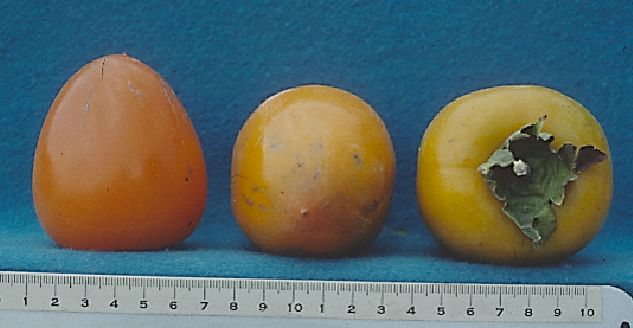
Credit: UF/IFAS Horticultural Sciences Department
Mid-Season Cultivars
'Eureka' has been widely propagated by southern nurseries and is a common cultivar in Texas (Figure 20). It has a large, round, flat-shaped, pollination-variant fruit with a medium amount of dark flesh around the seed.
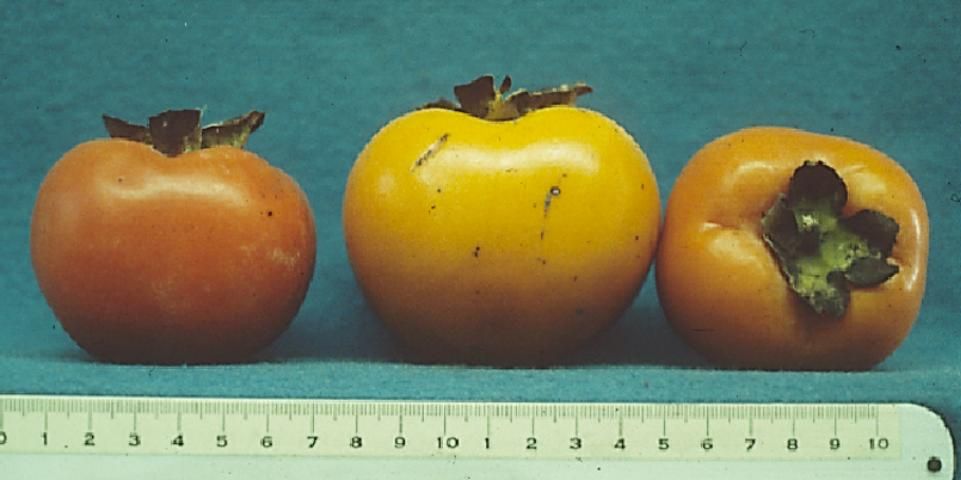
Credit: UF/IFAS Horticultural Sciences Department
'Sheng' is a well-spreading tree with large fruit having lobed sections looking somewhat like a 4- or 6-leaf clover from the top (Figure 21). Fruit have a high jelly content, are bright orange, and when pollinated will set many seed.
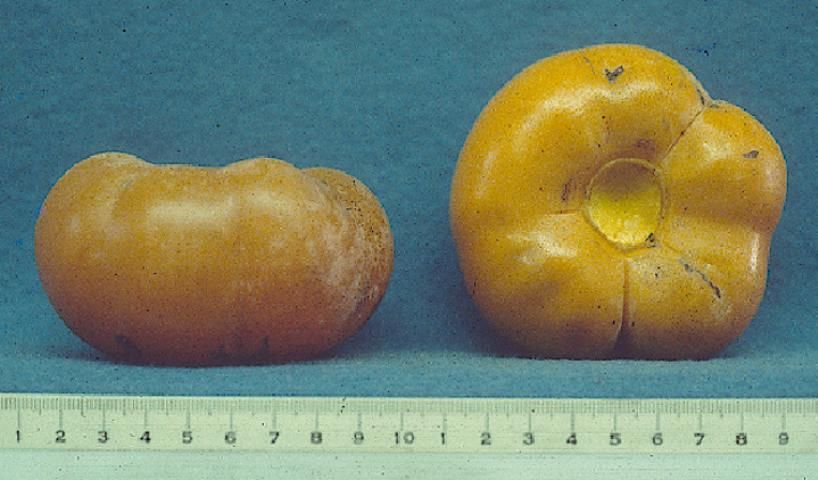
Credit: UF/IFAS Horticultural Sciences Department
'Yomato Hyakume' is a pollination-variant type, but it does not have a great deal of dark flesh around the seeds. The fruit are large, with a deep orange-red color (Figure 22). Concentric ring cracking often occurs. This cultivar is a heavy annual cropper with good fall leaf retention. It is excellent for dried fruit and is one of the best astringent types.
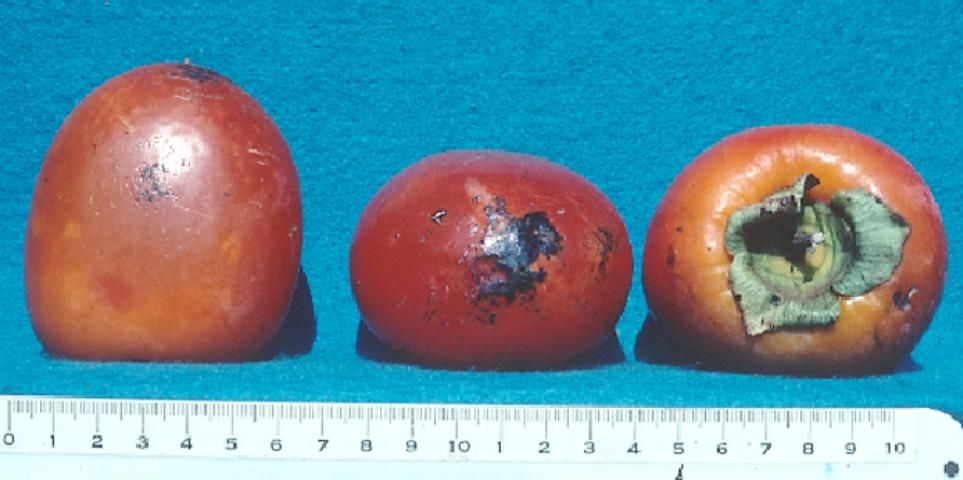
Credit: UF/IFAS Horticultural Sciences Department
'Tanenashi', the most popular astringent cultivar in Florida, matures heavy crops without pollination and will seldom set seed even if pollinated (Figure 23). It is usually desirable to thin the fruit to obtain some vegetative growth during the year. The fruit, often large (3½" across), can weigh over ¾ of a pound. Skin color is deep yellow to orange when mature. The flesh is orange, pasty, comparatively dry, and of acceptable quality. Soluble solids average 16%. Harvest duration may extend from September through November. It is a good tree for homeowners.

Credit: UF/IFAS Horticultural Sciences Department
'Hachiya' is a commercial cultivar in California (Figure 24). Ability to set and hold fruit is sometimes a problem if this cultivar is propagated onto Diospyros virginiana rootstock. The fruit are high quality and jelly-fleshed, with an attractive red skin coloration. Fruit will often have concentric ring cracking at the apical end and will ripen unevenly starting from these points. In Japan, 'Hachiya' is mostly used for drying. It remains astringent until fully ripened and soft.
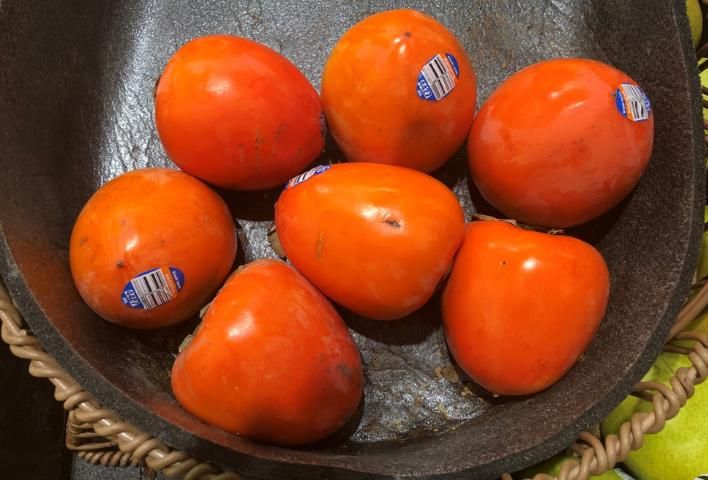
Credit: Ali Sarkhosh, UF/IFAS
'Hiratanenashi' is a widely grown commercial cultivar in Japan (Figure 25). The fruit have a thick peel and a long shelf life. The flesh is juicy, somewhat watery, and almost always seedless. The astringency is sometimes difficult to remove after the fruit have been harvested unless they are artificially treated.
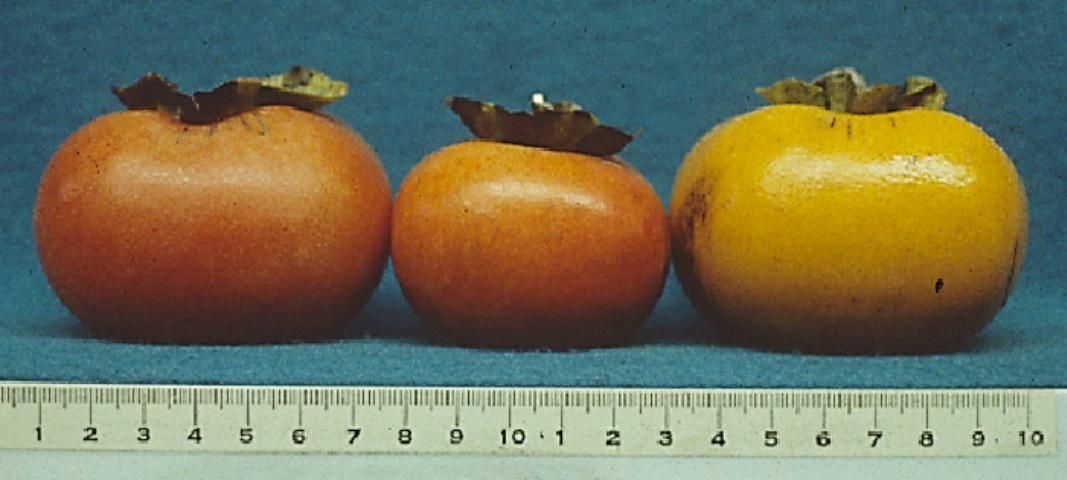
Credit: UF/IFAS Horticultural Sciences Department
'Great Wall' is a strong-growing, small, 4-sided fruit (Figure 26). The flesh is dry, similar to 'Tanenashi', but of excellent quality. It grows on an upright tree.
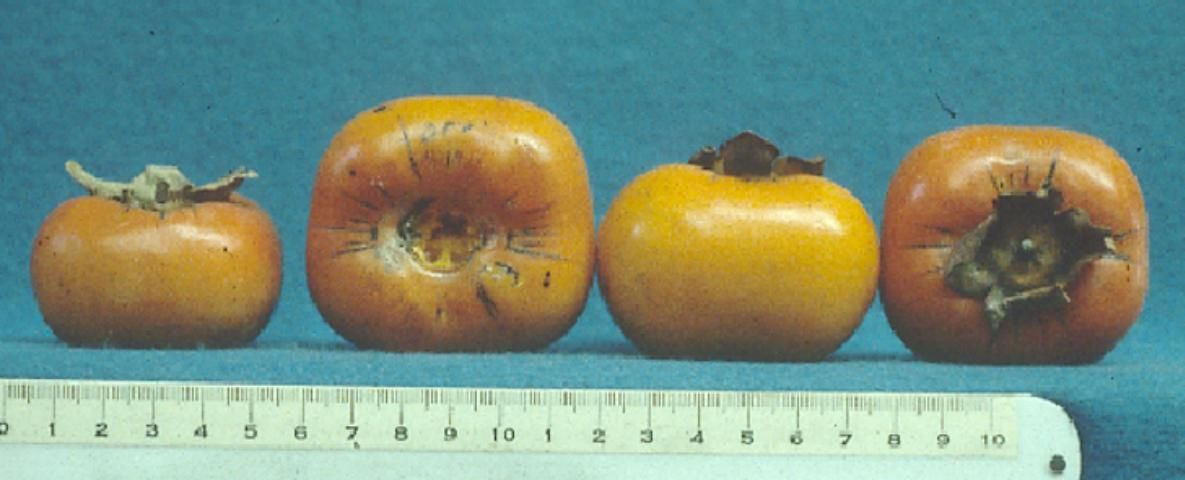
Credit: UF/IFAS Horticultural Sciences Department
'Tamopan' is a cultivar with large fruit having a circular depression around the top third nearest the stem (Figure 27). The fruit is juicy, watery, and stringy, with a thick peel. More than one cultivar of this tree exists, some of which have better fruit than the one described.
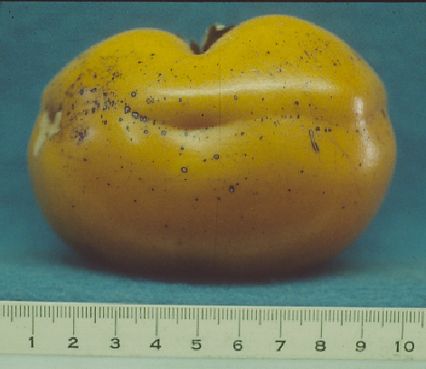
Credit: UF/IFAS Horticultural Sciences Department
'Ormond' is sometimes called the Christmas persimmon. Fruit are long, conic, and often harvested in January (Figure 28). The tree begins growing early in the spring, which increases chances for freeze injury. The fruit is juicy, with large seeds.
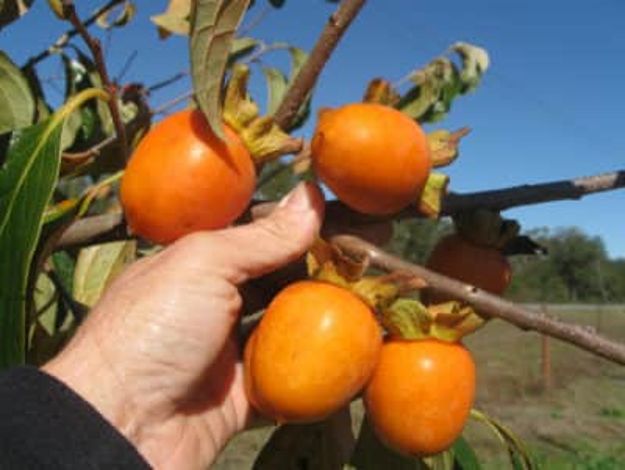
Credit: Just Fruits and Exotics
'Gailey' is the standard pollinating cultivar and has small to medium-size fruit. Concentric ring cracking is common, and its pollination-variant fruit are very dark-fleshed, even with small seed numbers.
Recommended Astringent Cultivars
Cultivars with good performance can be selected to represent a ripening season from mid-August to late December. They are 'Nishumura Wase', 'Saijo', 'Tanenashi', 'Yamato Hyakume', 'Sheng', and 'Ormond'. 'Nishumura Wase' and 'Ormond' are the early and late fruits. 'Saijo', 'Yamato Hyacume', and 'Sheng' have clear-fleshed, high-jelly-content fruit with top sugar readings. 'Tanenashi' is the most widely planted cultivar and generally has consistent production of large, medium-quality fruit.
References
USDA National Agricultural Statistics Service. 2017. "2017 Census of Agriculture, State and US Data."
Crandall, B. S., and W. L. Baker. 1940. "The Wilt Disease of American Persimmon Caused by Cephalosporium diospyri." Phytopathology 40: 307–325.
Edible Landscaping. https://ediblelandscaping.com/ (Source for some pictures).
Hodgson, R. W. 1939. "Floral Situation, Sex Condition, and Parthenocarpy in the Oriental Persimmon." Journal of the American Horticultural Society. 37: 250–252.
Itoo, S. 1986. "Persimmon." In Handbook of Fruit Set and Development. 355–370. Boca Raton: CRC Press.
Kitagawa, H., and P. Glucina. 1984. Persimmon Culture in New Zealand. Wellington, New Zealand: Science Information Publishing Center, DSIR.
Knapp, J. 1982. How to Build Orchard and Vineyard Trellises. Pittsburgh: Wire Products, U.S. Steel.
Marzolo, G. 2016. "Persimmon." Agricultural Marketing Resource Center. https://www.agmrc.org/commodities-products/fruits/persimmon
Mead, F. W. 1966. "Persimmon psylla." Entomology Circular No. 50. Florida Department of Agriculture, Division of Plant Industry.
Miller, E. P. 1989. "Performance of Non-astringent Persimmons (Diospryos kaki L.) in Florida." Proceedings of the Florida State Horticulture Society 102: 199–202.
Morton, J. F., and C. F. Dowling. 1987. Fruits of warm climates. Vol. 20534. Miami: JF Morton.
Sharpe, R. H. 1966. "Persimmon Variety and Rootstock Observations." Proc. of Fla. State Hort. Soc. 79: 374–379.
Taylor, W. A. 1913. "Promising New Fruits." Yearbook of the United States Department of Agriculture (1902-1913).
US Department of Agriculture. 1960. Index of Plant Diseases in the United States. Agriculture Handbook No. 165. Washington, DC: US Govt. Printing Office.
Performance of some nonastringent ornamental persimmon Diospyros kaki at the UF/IFAS NFREC–Monticello during 1996 (Peter Andersen).